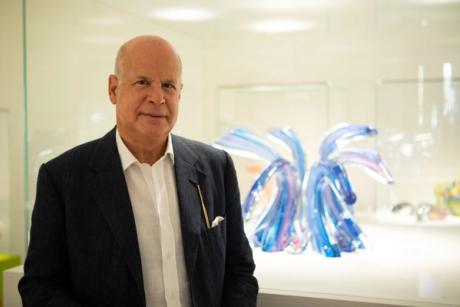
Is there a formula for creating a successful hub for nurturing, appreciating and understanding any branch of art? It did, and here’s how the Centro Studi del Vetro on the island of San Giorgio in Venice did it. It is about building an interconnecting system to which, in May, they added another vital element, the Archivio Generale del Vetro Veneziano, thus placing the Centro in a world-class category for its field.
First, show the actual art. Over the past ten years, the Stanze del Vetro, part of the Centro, have held two serious thematic exhibitions a year, the current one of the famous abstract, sculptural glass, produced in Czechoslovakia under communism, strangely free compared to the beautiful -arts which had to follow the socialist line (until November 26).
Second, collaborate with anyone, near or far, in similar fields, in order to form a critical mass and be seen as an ally and not as a threat. The indispensable ally in this case is the Fondazione Cini, which has a large part of the island in trust and is dedicated to research in the field of the arts.
Third, get on people’s agendas by hosting a regular, major event, like Centro’s highly publicized Venice Glass Week, held in conjunction with the distinguished Istituto Veneto di Scienze, Lettere ed Arti, which also shows glass and awards prizes to glassblowers. During this week, more than 100,000 scholars, makers, collectors and artists come from all over the world for activities, seminars and entertainment, such as the greenhouse-to-greenhouse marathon in Murano and the concerts of the glassblowers’ choir .
Fourth, fund scholarships and internships to work on your material, to make it available online, and to find the answers to questions such as why some greenhouses fail and others survive.
Fifth, publish your exhibits and research and build an essential reference library of books, periodicals, photo albums, videos and podcasts. The latest addition, the Archivio, is housed in the Sala Messina, a former dormitory for the monks of the island’s Benedictine monastery, which was restored by the Cini, with funding from the regions of Veneto, Trentino Alto Adige and Friuli-Venezia Giulia. , and the support of the Pentagram Stiftung, created by Rosi and David Landau in 2011 to support all the activities of the Centro.
The Archivio now houses more than 200,000 drawings, sketches and archives on Venetian glass, the most complete collection of such a material from the end of the 19th century to the present day. The fact that it exists now is vital because historic companies like Vetrerie Antonio Salviati have ceased operations and their papers are at risk of being lost or scattered. As it stands, 45,000 drawings and documents, and 948 photos of their 90 years of activity are now kept safe for posterity. The same goes for the 22,053 drawings, approximately 12,000 photos, 31 production catalogs tracing the activities of Seguso Vetri d’Arte. “Some of these models had ended up in Germany to be sold individually on ebay”, explains David Landau, “but we managed to buy them back”.
The Archivio also includes small samples of glass made according to the instructions of the brilliant young architect Carlo Scarpa for the firm MVM Cappellin & Co., which he joined in 1921 and which he wanted to make more adventurous by reviving complex techniques such as that watermarked a reticello.
And donations are already pouring in, like 450 drawings by the painter Dino Martens (who died in 1970), the artistic director of Aureliano Toso. These are particularly interesting because they have pieces of glass attached to the sheets as color samples, with arrows indicating how they should be used by the glassblower. The presence of 82,500 publications, drawings, photographs and manuscripts by one of the most famous Italian designers of modern times, Ettore Sottsass, who died in 2007, would be enough to make it a magnet for design students in general. And everyone can consult it: just make an appointment and its permanent team of two people will put everything at your disposal.
But as good as such a five-point formula for success is, it’s not good enough unless there’s a compelling reason to do the thing. David Landau says: “When I see so much potential for improving unjustly forgotten or unappreciated things, knowledge, sharing beauty and culture, I can’t resist trying to bring about change, to awaken good people, to function as a catalyst for change”. In this case, the change he and Rosi Landau are working for is nothing less than saving the old Venetian glass industry that is dying under the onslaught of cheap Chinese imitations, widespread misunderstanding and now of rising energy prices. These virtuoso skills, handed down over centuries, can lead, they believe, to the achievement of great works of art when so-called fine artists and craftsmen work together, a process that has begun but has in no way case reaches its full potential. Again.
